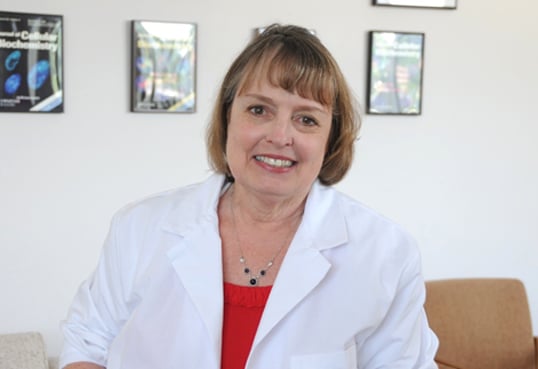Principal Investigator
Jeanne B Lawrence, Ph.D.

Leo P. and Theresa M. LaChance Chair in Medical Research
Professor of Neurology and Pediatrics
University of Massachusetts Chan Medical School
55 Lake Avenue North
Worcester, MA 01655
Phone: (508) 856-6015
Jeanne Lawrence is the Leo P. and Theresa M. LaChance Chair in Medical Research and Professor of Neurology and Pediatrics at the University of Massachusetts Chan Medical School (UMass Chan). After receiving an M.S. in Human Genetic Counseling she became intrigued by research into chromosomes and epigenetics, and thus earned her PhD in developmental biology from Brown University in 1982. She has been on the faculty of UMass Chan since 1985.
My lab’s research reflects my inter-disciplinary interests in fundamental epigenetic mechanisms in development and my training in clinical human genetics. Based on “informed intuition” I very early had a speculative believe that the nuclear genome was non-randomly organized in different cell-types, which motivated years of work to develop FISH and first demonstrate it was possible to visualize individual genes and RNAs in nuclear structure. A number of our earlier studies demonstrated that many expressed coding genes are organized with a variety of non-chromatin compartments/bodies, strongly affirmed by others genome-wide (see Smith et al., Current Opinions 2020). Another major discovery came when my lab first revealed (using our then new RNA FISH technology) that the non-coding XIST sequence (putative X-inactivation center) produced RNA exclusively from the inactive X-chromosome and the RNA structurally associates with the whole chromosome territory. These ground-breaking findings were key to establishing that XIST was the precedent for a large “non-coding” RNA that regulates chromatin (Hall et al., Current Opinions, 2016).
My lab has long been interested in the neglected “repeat genome”, another early interest before its time, which has grown more mainstream in recent years. For example, our exacting molecular cytology showed surprisingly abundant repeat-rich RNAs localize tightly to active chromosome territories, even after transcription inhibition, generating interest in the “CoT-1” (highly repetitive “junk”) genome (“masked” out in most studies) (Hall et al., Cell, 2014). Most recently, we developed stringent biochemical fractionation and RNAseq transcriptomics (including repeat families) to define a select subset of repeat-rich RNAs (Cot-1 RNA) that tightly embed with a non-chromatin territory scaffold (Creamer and Lawrence, Molec. Cell, 2021). While the current proposal focuses more on repeat-rich lncRNAs and intronic RNAs, another discovery advanced the now growing interesting in the large “inert” human Satellite II: we showed that this high-copy “silent” tandem repeat is actually highly expressed in ~half of various tumor types examined and sequesters epigenetic regulators in cancer-associated bodies (Hall et al, Cell Reports, 2017).
In addition to fundamental studies, in 2008 my lab embarked on an ambitious project to translate X-chromosome epigenetics to “silence trisomy 21” in Down syndrome (DS) patient stem cells. Even before the CRISPR revolution (and despite my lab’s lack of genetic engineering no-how at the time), my lab succeeded in precisely targeting the large XIST transgene into an extra Chr21 (using ZFNs); most importantly, we proved the remarkable capacity of the RNA to fully silence a trisomic autosome (Jiang et al., Nature 2013). Recently, we examined this in DS human neural cells, unexpectedly demonstrating that differentiated neural cells retain epigenetic plasticity to initiate chromosome silencing, and revealing that “trisomy silencing” enhances neuron formation by normalizing Notch pathway over-expression (Czerminski, Dev Cell, 2020).
